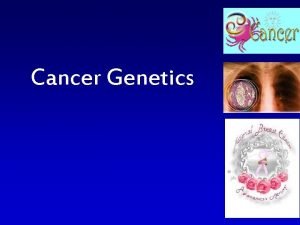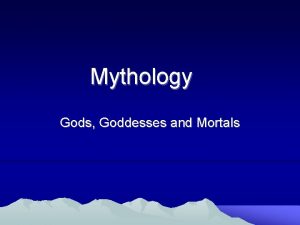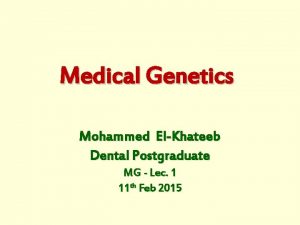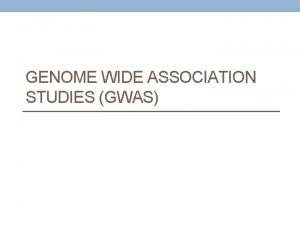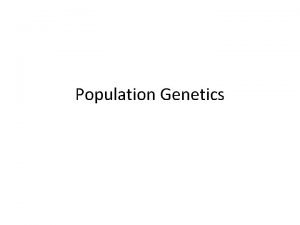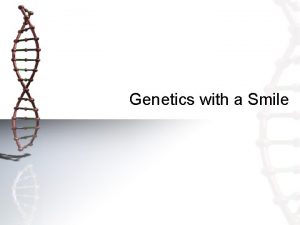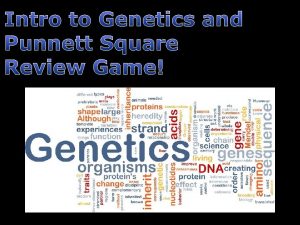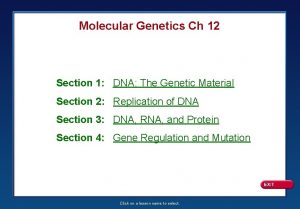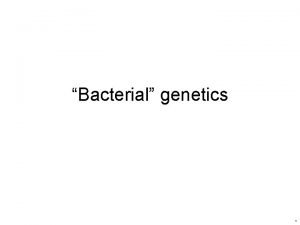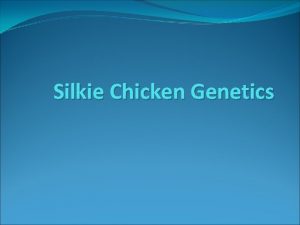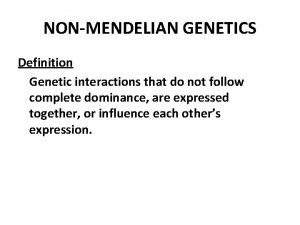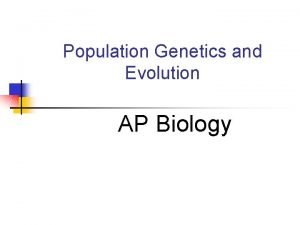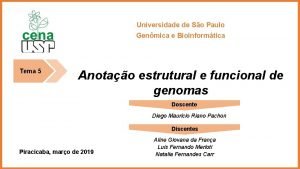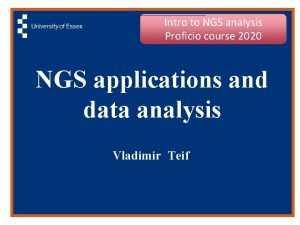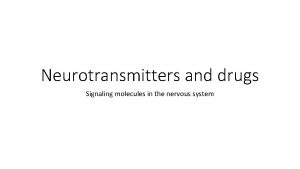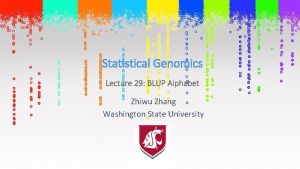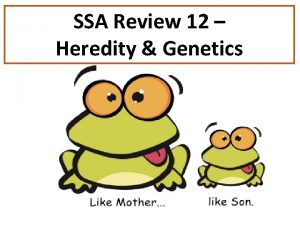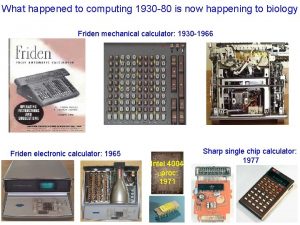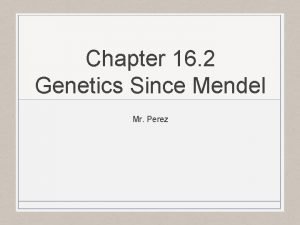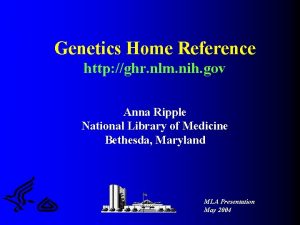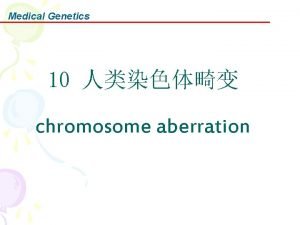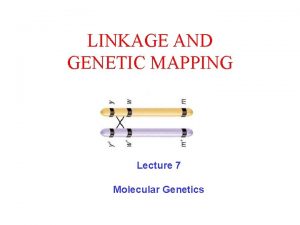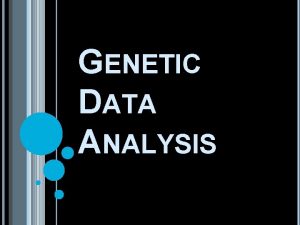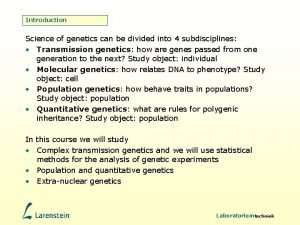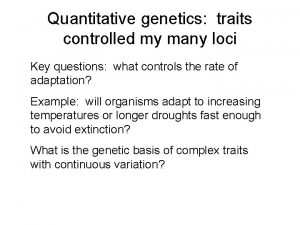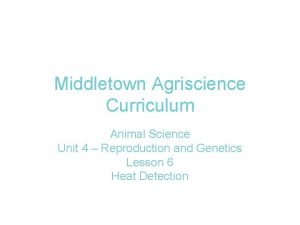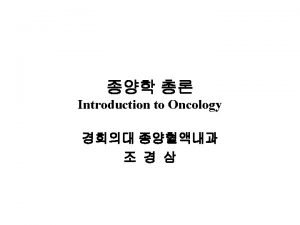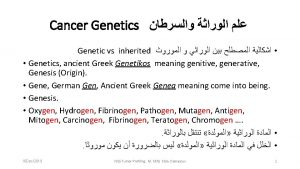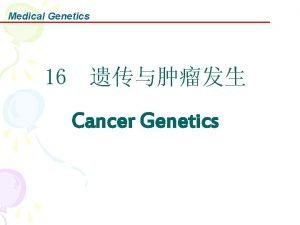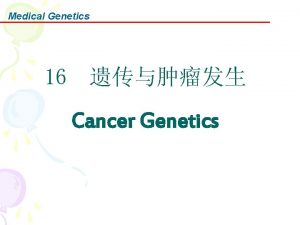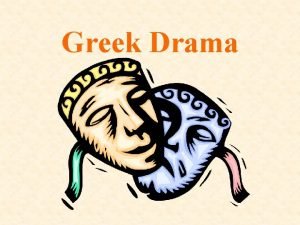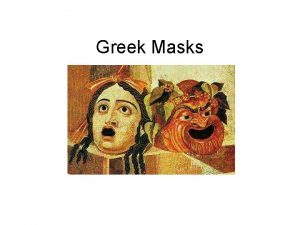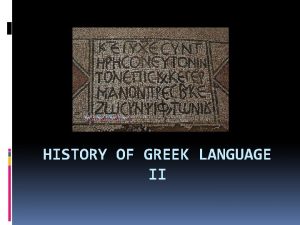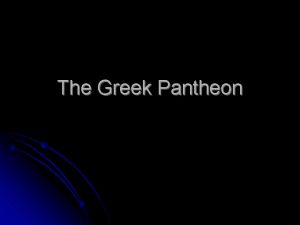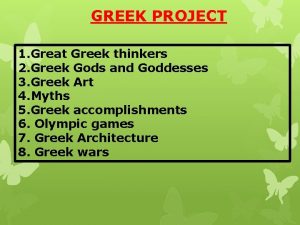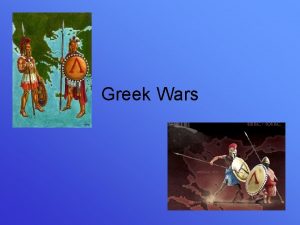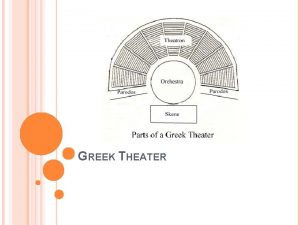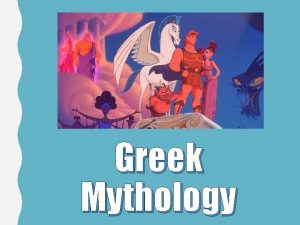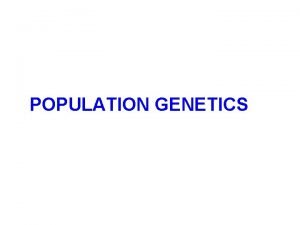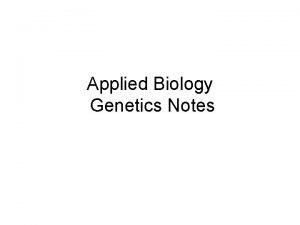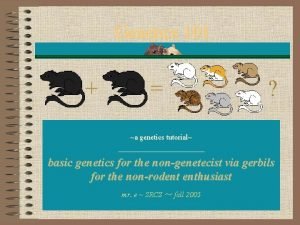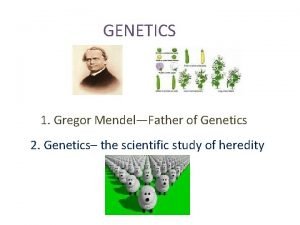Cancer Genetics What is cancer From Greek karkinos





































- Slides: 37

Cancer Genetics

What is cancer? § From Greek “karkinos” for “crab” § A group of diseases caused by loss of cell cycle control § Characterized by abnormal, uncontrolled cell growth

What causes cancer? § Begins with 1 or more mutations in a single somatic cell (a. k. a. the “bad apple”) § Mutation allows cell to divide when it normally would not § Further cell division produces more abnormal cells § Somatic cell mutations may be due to: § § Carcinogens Inheritance Natural mistakes in replication process Genetic predisposition to mutation/lack of mutational repair

Pre-cancer and cancer progression § Tumor – growth caused by cell escaping normal cell cycle control § Benign – tumor grows in one place § Malignant (cancerous) – spreading tumor § Local invasion by crab-like “arms” § Transportation through bloodstream § Metastisis (“not standing still”) – process of spreading of abnormal, malignant cells

Types of Cancer § Carcinomas: solid, epithelial tumors (skin, linings of body cavities) § Sarcomas: bone, cartilage, muscle and fat tumors § Leukemia: cancers of WBC’s produced in the bone marrow § Lymphomas: affect WBC’s in the spleen and lymph nodes

World view of cancer § “Environment-only” view of cancer lead to “War on Cancer” and legislation in 1971 § Targeting radiation, viruses, & chemicals § Fueled by lack of understanding of biology of disease § Genes first implicated in cancer in 1976

How Cells Become Cancerous: “The Two-Hit Hypothesis” § Somehow a normal cell is turned “cancerous” § Scientists believe it takes two “events” for this to happen § Examples of events § § § § X-rays Sunlight Drugs Chemicals Turning on of genes Virus exposure Oncogenes § These are all known as carcinogens

In US: Approx 1, 500, 000 new cases of cancer/year Approx 500, 000 deaths/year

Most Frequent Cancer Killers Men Women Lung Prostate Breast Colon/rectum Of the >200 types of cancers, 85% are CARCINOMAS

Mutations and Cancer § Mutations can occur: § In somatic cells => sporadic cancer only affecting the individual § In germline cells => mutations that are inherited § Accounts for 10% of cancers § usually require second somatic mutation

Telomeres and Cancer • When telomerase is absent, telomeres are not added. • Lack of telomeres signals cessation of cell division.

Telomeres and Cancer • Telomerase is the protein and enzyme complex that adds telomere sequences to the ends of chromosomes. • Presence of telomerase and telomeres allows cells to pass a cell cycle checkpoint and divide. • Cancer cells never lose their telomeres or telomerase

Cancer Cells Look & Act Different § Divide continually (given space and nutrients) § Heritable mutations: cells with mutations have daughter cells which inherit the same mutations. § Transplantable § Dedifferentiated: cells lose their specialized identity-they become stem cells § Different appearance: reflects dedifferentiation

Cancer Cells Look & Act Different § Lack contact inhibition: will divide in a crowd of cells and pile on top of each other § Induce angiogenesis (local blood vessel formation) § Increased mutation rate § Invasive: squeeze into any space available § Metastasize: cells move to new location in the body

A Little Known Fact § Tumor cells have the ability to redifferentiate into any kind of cells. They grow their own blood vessels and feed themselves § Tumors have been removed from patients with hair, teeth, and “mini-organs. ”

Types of cancer-causing genes Type of gene Normal function Mutated function Types of proteins Oncogene Promotes division (proto-oncogene) Promotes division abnormal time or cell type Growth factors Tumor Suppresses cell suppressor gene division Fails to suppress division Checkpoint molecules DNA repair gene mutation Fail to repair DNA mutations Enzymes for mismatch or excision repair Repair DNA mutations

Oncogenes § Proto-oncogenes are normal versions of genes which promote cell division. § Expression at the wrong time or in the wrong cell type leads to cell division and cancer. § Proto-oncogenes are called oncogenes in their mutated form. § One copy of an oncogenic mutation is sufficient to promote cell division.

Oncogenes: Over expression of a normal gene § Viruses integrated next to a proto-oncogene can cause transcription when the virus is transcribed. § Moving a proto-oncogene to a new location can separate the coding region from regulatory regions of the gene leading to incorrect expression. § Moving a proto-oncogene next to a highly transcribed gene can lead to erroneous transcription of the proto-oncogene.

How cellular oncogenes may cause cancer § Cellular proto-oncogenes play many different roles in normal cells. These roles include: § Growth factors (sis, int-2) § Receptors for growth factors (trk, fms) § Intracellular signalling proteins (ras, src) § Transcription factors (fos, myc) § These roles all involve growth and cell division

How cellular oncogenes may cause cancer § A proto-oncogene may promote cancer by keeping its growth factor permanently on. This causes abnormal growth and cell division § The oncogene may also become mutant, causing an abnormal protein to form, again affecting the rate of growth and cell division

How anti-oncogenes prevent cancer § Also known as tumor suppressors, these genes may function by keeping oncogenes turned off, or producing proteins which keep a cell from dividing repeatedly § The turning off of a tumor suppressor gene may cause tumor development § One gene, termed p 53, is known as the master-tumor suppressor gene § It is the most commonly altered gene in human cancers, accounting for over 50% of all diagnosed cases

How anti-oncogenes prevent cancer § P 53 normally functions by doing one of three things to abnormal cells 1. ) activate genes to promote DNA repair 2. ) activate genes to arrest cell division and slow proliferation 3. ) activate genes to promote apoptosis (cell death) § The turning on of p 53 stops an important cell regulator, leading to tumor growth

Inherited forms of cancer § Many forms of cancer are caused by multiple hits that involve the activation of oncogenes and the inactivation of tumor suppressor proteins (ex. Colo -rectal cancer) § People who have inherited forms of cancer are usually heterozygous for defective genes. Any mutation may hurt the good copy of the gene they have, deactivating their tumor suppressor gene, or activating an oncogene

Chronic Myelogenous Leukemia § Invariably fatal § The Philadelphia Chromosome § Reciprocal Translocation § long arm of HAS 22 < > small part of HSA 9 § 2 chromosomal changes § Translocation causes oncogene activation

CML § HSA 9 gene: Abelson oncogene (abl) § HSA 22 gene: breakpoint cluster region (bcr) § bcr-abl fusion gene encodes a form of tyrosine kinase § Tyrosine kinase is normal produce to abl § bcr-abl fusion version active for too long § Cell divides for too long § Gleevec- drug that binds ATP-binding pocket of tyrosine kinase, preventing the stimulation of cell division

Burkitt's Lymphoma § Common in Africa § Viral induced tumor of the immune system (B cell genes) § Usually associated with a reciprocal translocation between chromosomes 8 and 14. § Evidence for a oncogene (c-myc)

Tumor suppressor genes § Cancer can be caused by loss of genes that inhibit cell division. § Tumor suppressor genes normally stop a cell from dividing. § Mutations of both copies of a tumor suppressor gene is usually required to allow cell division.

Retinoblastoma § A rare childhood eye cancer § Alfred Knudson, 1971 examined cases of retinoblastoma in Houston from 1944 -69 and determined: § One eye or two with tumor § Age of diagnosis § Relatives with retinoblastoma § Number of tumors per eye § Observed that 50% of children of an affected parent were affected. § Boys and girls were equally frequently affected. § Children with bilateral (both eyes) tumors were diagnosed earlier.

Knudson’s two hit hypothesis § Two mutations are required, one in each copy of the RB gene (recessive expression) § For sporadic cases, retinoblastoma is a result of two somatic mutations § Mostly single-eye § For familial cases, retinoblastoma is inherited as an autosomal recessive mutation followed by a somatic mutation in the normal allele. § Can be both eyes, single eye, or none (“skips” generation)

p 53 coordinates cell cycle regulation § p 53 acts as a cell cycle protein which determines if a cell has repaired DNA damage. If damage cannot be repaired, p 53 can induce apoptosis. § More that 50% of human cancers involve an abnormal p 53 gene § Many different types of mutations in p 53 gene § e. g. colon, breast, bladder, lung, liver, blood, brain, esophagus, skin § Rare inherited mutations in the p 53 gene cause a disease called Li-Fraumeni syndrome in which family members have many different types of cancer at early ages.

BRCA 1, a breast cancer susceptibility gene § BRCA 1 – breast cancer predisposition gene 1 § tumor suppressor gene § Within families a mutation in BRCA 1 leads to breast cancer susceptibility, inherited as a dominant trait. § One mutation in the BRCA 1 gene is inherited. § Tumors in people acquire a second mutation in the normal allele of BRCA 1. § Lack of any functional BRCA 1 leads to cancer cells. § At the level of the cell, BRCA 1 acts in a recessive manner.

Complexities in genetic counseling for familial breast cancer § Many mutations are known but not all are associated with disease Some are polymorphisms § Individuals with inherited predisposition and individuals with sporadic cancer can be found within the same family. § BRCA 1 and BRCA 2 are not fully penetrant. Occasionally individuals with a mutation do not develop cancer. § Risk associated with BRCA 1 or BRCA 2 mutations depends on interaction with other genes & environmental exposures

Colon cancer results from genetic alterations in multiple genes • Inherited mutations in the APC gene dramatically increase risk of colon cancer • 5% of cases are inherited • 1/5, 000 in US have precancerous colon polyps



Environment impacts cancer § Exposure to carcinogens § Carcinogens in tobacco smoke are correlated with lung cancer incidence. § Exposure to radiation § Burns from overexposure to sunlight can cause skin cancer. § Variation in diet § Fatty diets are correlated with increased estrogen and increased breast cancer.

The Skin Cancer Epidemic § The most common form of human cancer § 1 in 5 lifetime risk. § Tenfold increase since 1967!!! § Like many cancers, your actions can prevent or limit your chances of having this disease……
 Karkinos greek
Karkinos greek What is the greek miracle in greek mythology
What is the greek miracle in greek mythology Bottleneck effect
Bottleneck effect Gwas method
Gwas method Genetics
Genetics Genetics with a smile
Genetics with a smile Clinodactyly
Clinodactyly Punnett square review games
Punnett square review games Molecular genetics chapter 12
Molecular genetics chapter 12 Nature review genetics
Nature review genetics Mendel monk
Mendel monk What is genetics in biology
What is genetics in biology Silkie color genetics
Silkie color genetics Complete dominance definition
Complete dominance definition Genetics
Genetics Nature review genetics
Nature review genetics Genetics
Genetics Nature review genetics
Nature review genetics Http://learn.genetics.utah.edu/content/addiction/
Http://learn.genetics.utah.edu/content/addiction/ Nature genetics
Nature genetics Blood type alleles
Blood type alleles Genetics
Genetics Is curly hair dominant
Is curly hair dominant Nature genetics
Nature genetics Foil method for dihybrid crosses
Foil method for dihybrid crosses Extending mendelian genetics
Extending mendelian genetics Genetics since mendel
Genetics since mendel Genetics home reference
Genetics home reference Tongue rolling genetics
Tongue rolling genetics Genetics
Genetics Apgar score
Apgar score Genetics
Genetics Probability image
Probability image Genetic drift
Genetic drift Parent offspring regression
Parent offspring regression How do you know if a karyotype is male or female
How do you know if a karyotype is male or female Introduction to genetic analysis tenth edition
Introduction to genetic analysis tenth edition Genetics middletown
Genetics middletown
